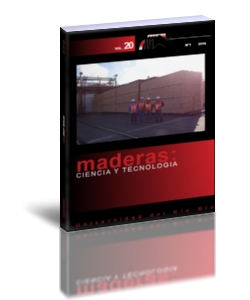Impact of feed rate, milling depth and tool rake angle in peripheral milling of oak wood on the cutting force
Keywords:
peripheral milling, cutting forces, cutting regime, tool rake angle, machinabilityAbstract
The paper presents the results of investigations performed in the peripheral milling of oak wood (Quercus robur), where the impact of cutting regime elements and tool geometry on the cutting force is analyzed. A large-scale experiment was conducted to implement the obtained results in developing a reliable analytical and simulation model for analyzing and predicting the cutting forces, depending on the feed rate, the milling depth and the tool rake angle. The generated mathematical model is adequate and describes accurately enough the dependence of the cutting forces upon the selected impact factors in the adopted test conditions. The evaluation of the model parameters significance indicates a significant impact of feed rate and milling depth, whereas tool rake angle does not show any significant impact in this case. The developed mathematical model can be employed in manufacturing conditions as an indicator of wood and wood-based materials machinability.
Downloads
References
Aguilera, A.; Muñoz, H. 2011. Rugosidad superficial y potencia de corte en el cepillado de Acacia melanoxylon y Sequoia sempervirens. Maderas-Cienc Tecnol 13(1): 19-28.
Aguilera, A.; Zamora, R. 2009. Surface roughness in sapwood and heartwood of Blackwood (Acacia melanoxylonR. Br.) machined in 90-0 direction. European Journal of Wood Products 67: 297-301.
Axelsson, B.; Lundberg, S.; Grönlund, A. 1993. Studies of the main cutting force at and near a cutting edge. Holz als Roh und Werkstoff 52: 43-48.
Barcik, Š.; Pivuloskova, E.; Kminiak, R. 2008. Effect of technological parameters and wood properties on cutting power in plane milling of juvenilie poplar wood. Drvna industrija 59 (3): 107-112.
Belleville B, Ashley P, Ozarska B (2016). Wood planing properties of Australian plantation-grown eucalypts. Maderas-Cienc Tecnol 18(3):425-434.
Eyma, F.; Méaуsoone, P.; Martin, P. 2004. Study of the properties of thirteen tropical wood species to improve the prediction of cutting forces in mode B. Annals of Forest Science 61 (2004): 55-64.
Goglia, V. 1994. Tools and machines for wood processing I. University of Zagreb – Faculty of Forestry, Zagreb, Croatia (In Croatian).
Goli, G.; Uzielli, L. 2004. Mechanisms of wood surface formation and resulting final condition after planing. In S. E. Stanzl-Tschegg, M. Gindl, & G. Sinn (Eds.), Proceedings of the 2nd International Symposium on Wood Machining, BOKU, Vienna, Austria: 451-457.
Günay, M.; Korkut, I.; Aslan, E.; Şeker, U. 2005. Experimental investigation of the effect of cutting tool rake angle on main cutting force. Journal of Materials Processing Technology 166(1): 44-49.
Kalajdžić, M. 2008. Machine building. Faculty of Mechanical Engineering, Belgrade. (In Serbian)
Krilek, J.; Kováč, J.; Kučera, M. 2014. Wood Cross cutting Process Analysis for Circular Saws. BioResources 9(1): 1417-1429.
Kršljak, B. 2013. Tools and machines for wood processing I. University of Belgrade, Faculty of Forestry, Belgrade. (In Serbian).
Mandić, M.; Porankiewicz, B.; Danon, G. 2015. An Attempt at Modelling of Cutting Forces in Oak Peripheral Milling. BioResources 10(3): 5489-5502.
Mason, R.; Gunst R.; Hess J. 2003. Statistical Design and Analysis of Experiments: With Applications to Engineering and Science. 2nd Edition, Wiley.
Naylor, A.; Hackney, P.; Perera, N.; Clahr, E. 2012. A predictive model for the cutting force in wood machining developed using mechanical properties. BioResources 7(3): 2883-2894.
Orlicz, T. 1982. Obróbka drewna narzędziami tnącymi. (Machining of wood with use of cutting tools), Study book SGGW-AR, Warsaw, Poland.
Porankiewicz, B.; Axelsson, B.; Grönlund, A.; Marklund, B. 2011. Main and normal cutting forces by machining of wood of Pinus sylvestris. BioResources 6(4): 3687-3713.
Porankiewicz, B.; Goli, G. 2014. Cutting forces by Oak and Douglas fir machining. Maderas-Cienc Tecnol 16(2): 199-216.
Stanić, J. (1989). Theory of metal processing. Mechanical Engineering, University of Belgrade, Belgrade 218–259.
Thoma, H.; Peri, L.; Lato, E. 2015. Evaluation of wood surface roughness depending on species characteristics. Maderas-Cienc Tecnol 17(2): 285-292.
Wen-Hsiang, L. 2000. Modeling of Cutting Forces in End Milling Operations. Tamkang Journal of Science and Engineering 3(1): 15-22.
Yanda, H.; Ghani, J. A.; Hassan, C.; Haron, C. 2010. Effect of Rake Angle on Stress, Strain and Temperature on the Edge of Carbide Cutting Tool in Orthogonal Cutting Using FEM Simulation. Journal of Engineering and Technological Sciences 42(2): 179-194.

































